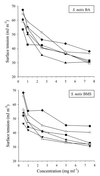Inhibition of Streptococcus mutans NS adhesion to glass with and without a salivary conditioning film by biosurfactant- releasing Streptococcus mitis strains
- PMID: 10653732
- PMCID: PMC91877
- DOI: 10.1128/AEM.66.2.659-663.2000
Inhibition of Streptococcus mutans NS adhesion to glass with and without a salivary conditioning film by biosurfactant- releasing Streptococcus mitis strains
Abstract
The release of biosurfactants by adhering microorganisms as a defense mechanism against other colonizing strains on the same substratum surface has been described previously for probiotic bacteria in the urogenital tract, the intestines, and the oropharynx but not for microorganisms in the oral cavity. Two Streptococcus mitis strains (BA and BMS) released maximal amounts of biosurfactants when they were grown in the presence of sucrose and were harvested in the early stationary phase. The S. mitis biosurfactants reduced the surface tensions of aqueous solutions to about 30 to 40 mJ m(-2). Biochemical and physicochemical analyses revealed that the biosurfactants released were glycolipids. An acid-precipitated fraction was extremely surfactive and was identified as a rhamnolipidlike compound. In a parallel-plate flow chamber, the number of Streptococcus mutans NS cells adhering to glass with and without a salivary conditioning film in the presence of biosurfactant-releasing S. mitis BA and BMS (surface coverage, 1 to 4%) was significantly reduced compared with the number of S. mutans NS cells adhering to glass in the absence of S. mitis. S. mutans NS adhesion in the presence of non-biosurfactant-releasing S. mitis BA and BMS was not reduced at all. In addition, preadsorption of isolated S. mitis biosurfactants to glass drastically reduced the adhesion of S. mutans NS cells and the strength of their bonds to glass, as shown by the increased percentage of S. mutans NS cells detached by the passage of air bubbles through the flow chamber. Preadsorption of the acid-precipitated fraction inhibited S. mutans adhesion up to 80% in a dose-responsive manner. These observations indicate that S. mitis plays a protective role in the oral cavity and protects against colonization of saliva-coated surfaces by cariogenic S. mutans.
Figures

Similar articles
-
Streptococcus thermophilus and its biosurfactants inhibit adhesion by Candida spp. on silicone rubber.Appl Environ Microbiol. 1997 Oct;63(10):3810-7. doi: 10.1128/aem.63.10.3810-3817.1997. Appl Environ Microbiol. 1997. PMID: 9327543 Free PMC article.
-
The influence of biosurfactants released by S. mitis BMS on the adhesion of pioneer strains and cariogenic bacteria.Biofouling. 2004 Dec;20(6):261-7. doi: 10.1080/08927010400027050. Biofouling. 2004. PMID: 15788225
-
Secretory IgA adsorption and oral streptococcal adhesion to human enamel and artificial solid substrata with various surface free energies.J Biomater Sci Polym Ed. 1991;2(4):239-53. doi: 10.1163/156856291x00142. J Biomater Sci Polym Ed. 1991. PMID: 1772830
-
Adhesion of mutants streptococci to glass with and without a salivary coating as studied in a parallel-plate flow chamber.J Dent Res. 1992 Mar;71(3):491-500. doi: 10.1177/00220345920710031301. J Dent Res. 1992. PMID: 1573082
-
Salivary proteins promote proteolytic activity in Streptococcus mitis biovar 2 and Streptococcus mutans.Mol Oral Microbiol. 2012 Oct;27(5):362-72. doi: 10.1111/j.2041-1014.2012.00650.x. Epub 2012 May 25. Mol Oral Microbiol. 2012. PMID: 22958385
Cited by
-
Impact of alginate conditioning film on deposition kinetics of motile and nonmotile Pseudomonas aeruginosa strains.Appl Environ Microbiol. 2007 Aug;73(16):5227-34. doi: 10.1128/AEM.00678-07. Epub 2007 Jun 15. Appl Environ Microbiol. 2007. PMID: 17574995 Free PMC article.
-
Inhibition of Bacterial Adhesion and Antibiofilm Activities of a Glycolipid Biosurfactant from Lactobacillus rhamnosus with Its Physicochemical and Functional Properties.Antibiotics (Basel). 2021 Dec 17;10(12):1546. doi: 10.3390/antibiotics10121546. Antibiotics (Basel). 2021. PMID: 34943758 Free PMC article.
-
Effect of xylitol on cariogenic and beneficial oral streptococci: a randomized, double-blind crossover trial.Iran J Microbiol. 2012 Jun;4(2):75-81. Iran J Microbiol. 2012. PMID: 22973473 Free PMC article.
-
Determining the potential use of biosurfactants in preventing endodontic infections.Eur J Oral Sci. 2022 Dec;130(6):e12900. doi: 10.1111/eos.12900. Epub 2022 Nov 3. Eur J Oral Sci. 2022. PMID: 36326688 Free PMC article.
-
Effects of biosurfactants on the viability and proliferation of human breast cancer cells.AMB Express. 2014 Apr 15;4:40. doi: 10.1186/s13568-014-0040-0. eCollection 2014. AMB Express. 2014. PMID: 24949273 Free PMC article.
References
-
- Busscher H J, Bruinsma G, van Weissenbruch R, Leunisse C, van der Mei H C, Dijk F, Albers F W J. The effect of buttermilk consumption on biofilm formation on silicone rubber prostheses in an artificial throat. Eur Arch Otorhinolaryngol. 1998;255:410–413. - PubMed
-
- Dawes C, Watanabe S, Biglow-Lecomte P, Dibdin G H. Estimation of the velocity of the salivary film at some different locations in the mouth. J Dent Res. 1989;68:1479–1482. - PubMed
-
- Desai J D, Desai A J. Production of biosurfactants. In: Kosaric N, editor. Biosurfactants. Production, properties, applications. New York, N.Y: Marcel Dekker, Inc.; 1993. pp. 65–97.
MeSH terms
Substances
LinkOut - more resources
Full Text Sources
Other Literature Sources
Miscellaneous

